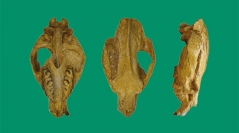

 Comptes Rendus Palevol
22 (8) - Pages 109-142
Comptes Rendus Palevol
22 (8) - Pages 109-142Amynodontidae Scott & Osborn, 1883 are an extinct family of Rhinocerotoidea Owen, 1845 known from the middle Eocene to the latest Oligocene of Asia, North America, and Europe. We report here two unpublished specimens of Amynodontidae, a skull and a mandible of Zaisanamynodon borisovi Belyaeva, 1971 from the late Eocene of the Zaysan Basin (Kazakhstan) and a skull of Metamynodon planifrons Scott & Osborn, 1887, from the early Oligocene of the Big Badlands (United States). This new material has been incorporated into a morpho-anatomical character matrix. It was completed with the coding of the recently described species of Amynodontopsis jiyuanensis Wang X.-Y., Wang Y.-Q., Zhang R., Zhang Z.-H., Liu & Ren, 2020 and the revised coding of Cadurcotherium cayluxi Gervais, 1873 and Cadurcotherium minum Filhol, 1880. We computed a cladistic analysis based on this matrix, including 31 Rhinocerotoidea terminal taxa. The new phylogenetic hypothesis proposed allows to discuss the relationships of the referred specimens within Amynodontidae and those of Amynodontidae within Rhinocerotoidea. Our cladistic analysis clarifies the generic and specific composition of the tribes Metamynodontini Kretzoi, 1942 and Cadurcodontini Wall, 1982 and supports the monophyly of the genus Zaisanamynodon Belyaeva, 1971. The dichotomy between the two tribes is notably expressed by the presence of several cranial features such as “the deep nasal notch” or “the well-developed preorbital fossa” in Cadurcodontini. These cranial specializations attest to an adaptation of the peri-nasal region to the presence of a proboscis with a feeding function. Our study also opens a discussion on the biogeography of Amynodontidae, their emergence and dispersal in Asia and their subsequent migration to North America, and Eastern Europe. Their presence in Western Europe remains restricted to the Oligocene, after a dispersal related to the “Grande Coupure” event.
Amynodontidae, Zaisanamynodon, Metamynodon, phylogénie, crâne, Bassin Zaïssan, Big Badlands, Éocène, Oligocène, Rhinocerotoidea